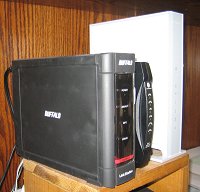- By Dan Veaner
- Business & Technology
 Print
Print  Dr. DigitDr. Digit 'Splains It All
Dr. DigitDr. Digit 'Splains It AllAre you the kind of person who lives on the edge? In other words do you skip making regular backups of your computer hard drive? And has your computer hard drive ever crashed? Did you lose anything important? Or everything important? How long did it take you to recover from that? And do you need more space for your MP3s, or videos or pictures that you download?
I solved both by buying a Network Accessible Storage (NAS) device. That's just a fancy way of saying that it's a hard drive that doesn't need to be attached to a computer to use it. In other words if your computer is on you can access it. If your kid's computer is on he or she can access it. But your computer doesn't have to be on for your kid to use it, and vice versa. It just sits on my desk next to my modem and router. Though it wouldn't have to -- as long as you can plug it into your router it can be anywhere in your house.
NAS devices plug into your network, and work in a similar way to file sharing among computers. You can set them up so only some people can access certain folders, or so that everyone can access all of them. Some NAS devices even let you access the files you keep on them over the Internet, a great feature if you travel a lot. In my house we have a folder for each family member, one for the Lansing Star, and a couple of generic folders that we use to share things.
This has many advantages. I can't tell you how many times the kids' computer upstairs lost touch with the printer downstairs. Using the NAS they can store their homework in their own folders, then access them downstairs on my computer, which always seems to be able to print for some reason. Or if they both have a lot of homework one of them can do it on my computer, getting their files from the same place as always.
Experts will tell you that it is best to have two physical hard drives for your computer. You should have your operating system and all your programs on the first one, and all your data -- documents, spreadsheets, music, videos, pictures, etc. on the second. This makes programs load faster, because there are fewer opportunities for disk fragmentation on the first drive, while keeping everything you might want to back up in one place on the second.
A little known fact about Windows is that you can reassign the actual location of "My Documents." I reassigned mine to my folder on the NAS. Even though the NAS isn't a part of my computer, it effectively acts as if it is. When I go to My Documents I am accessing that folder on the NAS. That saves a ton of storage space on my computer's hard drive, and makes it easy to access my files from other computers hooked up to the network. That comes in handy sometimes.
I wouldn't do that for a notebook computer, because when traveling I wouldn't be hooked up to the NAS. But when the notebook is attached to my own network I can get those files from it just as I can from any desktop.

Buffalo LinkStation
Before buying my NAS I went onto the Internet to read comments by people using different brands and models. One complaint was that NAS devices, at least the lower end ones that a home or small office user would get, are slow. Some complained of setup and maintenance issues, or just plain lousy manuals.
I settled on the Buffalo LinkStation, which comes with various storage capacities -- I got a 300 gigabyte drive. You can get them much larger, but the price also gets larger if you do.
To be honest, I am delighted with it. The physical setup was as simple as plugging a power cord into the wall and an Ethernet (CAT5) cable into my network router. You configure the device in your Web Browser, including scheduling backups and basic or advanced features. I do not find that the LinkStation is particularly slow. Sometimes there is an almost imperceptible delay, but it seems to run faster than an external USB drive directly connected to the computer.
I also don't find it particularly noisy. The USB drives I attached to it are noisier than the LinkStation is. I know that because I typically notice the noise when I am in the room during a backup while my computer is turned off. When a backup is not happening, the USB drives go to sleep, and I can barely hear the NAS even when someone elsewhere in the house is accessing it. If the noise starts to bother me I'll get a 50 foot CAT5 cable and relocate the NAS and the two USB drives in the basement.
By formatting the USB drives a certain way (in the browser-based configuration program -- it was very simple and only took a few minutes) I can also access them from any computer on my network. So I set the backup programs on my desktop and a laptop to do that. That way any important files I don't keep on the NAS are still safe.
All in all my NAS was a good purchase. I have had no issues with it in the four months I have had it, and the benefits have been so plentiful that I can't imagine how I computed without it.
----
v4i7




